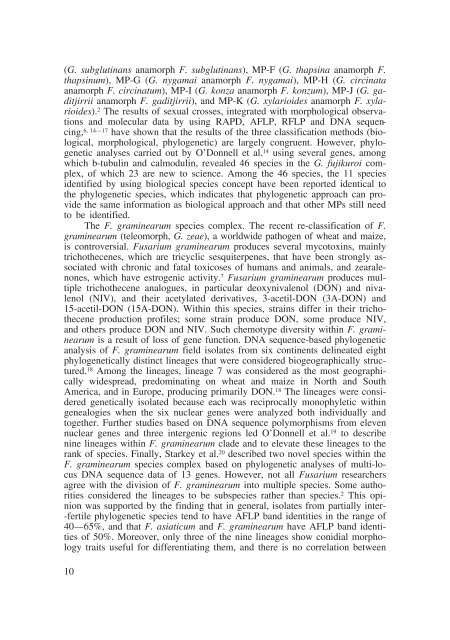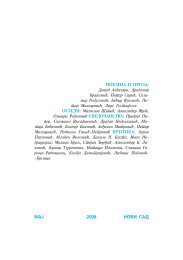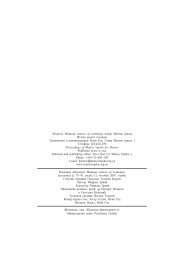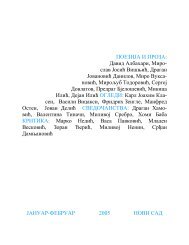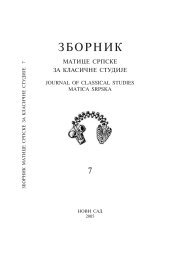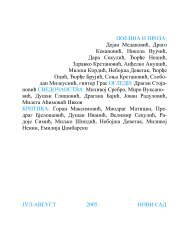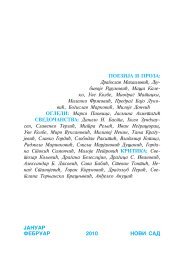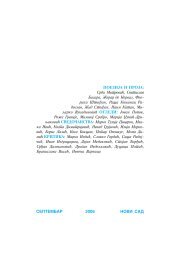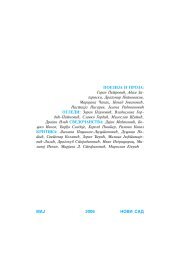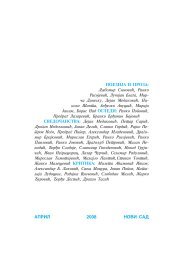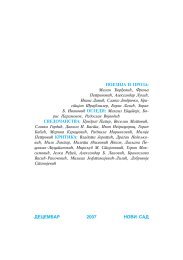ЗБОРНИК - Matica srpska
ЗБОРНИК - Matica srpska
ЗБОРНИК - Matica srpska
Create successful ePaper yourself
Turn your PDF publications into a flip-book with our unique Google optimized e-Paper software.
(G. subglutinans anamorph F. subglutinans), MP-F (G. thapsina anamorph F.<br />
thapsinum), MP-G (G. nygamai anamorph F. nygamai), MP-H (G. circinata<br />
anamorph F. circinatum), MP-I (G. konza anamorph F. konzum), MP-J (G. gaditjirrii<br />
anamorph F. gaditjirrii), and MP-K (G. xylarioides anamorph F. xylarioides).<br />
2 The results of sexual crosses, integrated with morphological observations<br />
and molecular data by using RAPD, AFLP, RFLP and DNA sequencing,<br />
6, 14—17 have shown that the results of the three classification methods (biological,<br />
morphological, phylogenetic) are largely congruent. However, phylogenetic<br />
analyses carried out by O'Donnell et al. 14 using several genes, among<br />
which b-tubulin and calmodulin, revealed 46 species in the G. fujikuroi complex,<br />
of which 23 are new to science. Among the 46 species, the 11 species<br />
identified by using biological species concept have been reported identical to<br />
the phylogenetic species, which indicates that phylogenetic approach can provide<br />
the same information as biological approach and that other MPs still need<br />
to be identified.<br />
The F. graminearum species complex. The recent re-classification of F.<br />
graminearum (teleomorph, G. zeae), a worldwide pathogen of wheat and maize,<br />
is controversial. Fusarium graminearum produces several mycotoxins, mainly<br />
trichothecenes, which are tricyclic sesquiterpenes, that have been strongly associated<br />
with chronic and fatal toxicoses of humans and animals, and zearalenones,<br />
which have estrogenic activity. 7 Fusarium graminearum produces multiple<br />
trichothecene analogues, in particular deoxynivalenol (DON) and nivalenol<br />
(NIV), and their acetylated derivatives, 3-acetil-DON (3A-DON) and<br />
15-acetil-DON (15A-DON). Within this species, strains differ in their trichothecene<br />
production profiles; some strain produce DON, some produce NIV,<br />
and others produce DON and NIV. Such chemotype diversity within F. graminearum<br />
is a result of loss of gene function. DNA sequence-based phylogenetic<br />
analysis of F. graminearum field isolates from six continents delineated eight<br />
phylogenetically distinct lineages that were considered biogeographically structured.<br />
18 Among the lineages, lineage 7 was considered as the most geographically<br />
widespread, predominating on wheat and maize in North and South<br />
America, and in Europe, producing primarily DON. 18 The lineages were considered<br />
genetically isolated because each was reciprocally monophyletic within<br />
genealogies when the six nuclear genes were analyzed both individually and<br />
together. Further studies based on DNA sequence polymorphisms from eleven<br />
nuclear genes and three intergenic regions led O'Donnell et al. 19 to describe<br />
nine lineages within F. graminearum clade and to elevate these lineages to the<br />
rank of species. Finally, Starkey et al. 20 described two novel species within the<br />
F. graminearum species complex based on phylogenetic analyses of multi-locus<br />
DNA sequence data of 13 genes. However, not all Fusarium researchers<br />
agree with the division of F. graminearum into multiple species. Some authorities<br />
considered the lineages to be subspecies rather than species. 2 This opinion<br />
was supported by the finding that in general, isolates from partially inter-<br />
-fertile phylogenetic species tend to have AFLP band identities in the range of<br />
40—65%, and that F. asiaticum and F. graminearum have AFLP band identities<br />
of 50%. Moreover, only three of the nine lineages show conidial morphology<br />
traits useful for differentiating them, and there is no correlation between<br />
10


